ViewSonic VX2475Smhl-4K 24-Inch UHD Monitor Review
ViewSonic's new VX2475Smhl-4K is a 24-inch IPS panel that's currently one of the least expensive Ultra HD monitors available. Today we run it through our lab and hands-on tests.
Why you can trust Tom's Hardware
Grayscale Tracking And Gamma Response
Our grayscale and gamma tests are described in detail here.
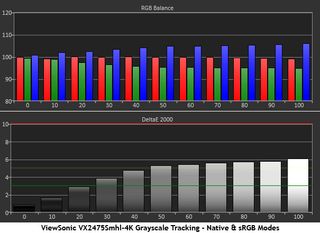
Many of our latest review subjects have shown excellent out-of-box grayscale accuracy; enough so that calibration can be considered optional. The VX2475Smhl-4K doesn't quite fall into that category. While the blue tint isn't grievous, it is visible at 30 percent brightness and higher. You'll want to reduce the blue slider a few clicks to compensate.

After changes to the blue and red sliders and a one-click reduction in the contrast control, we measured excellent grayscale tracking. Even though this monitor costs over $400, it's at the low end of the UHD price range. Obviously its factory setup isn't done quite as carefully as more expensive screens.
Here is our comparison group showing results of grayscale error tests.

A year or two ago, this would have been an average out-of-box result. Today's monitors have upped the standard to where calibration isn't always required; and truth be told, the VX2475Smhl-4K is usable without one. But if you're picky about color, we recommend taking those additional steps. If you use our suggested settings, you'll be pretty close to our result below.
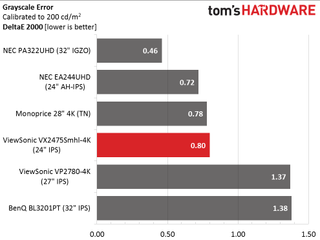
Obviously the VX is capable of excellent grayscale performance. We cheer any time a monitor beats one Delta E in this test. We consider that to be professional-grade performance.
Gamma Response
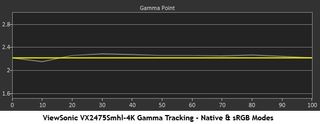
Since there is no gamma control we can't do anything to adjust its tracking. In the VX2475Smhl-4K's Native mode it's pretty much right on target with only the tiniest of aberrations at 10, 30 and 80 percent. But let's see what happens after calibration.

This is one of those rare instances where gamma performance gets slightly worse with calibration. Don't get us wrong, it's not a big deal in this case. You won't be able to see a problem and the improved color accuracy is more than worth it. Tracking as a whole gets a tad lighter with a dip at 90 percent.
Here is our comparison group again.
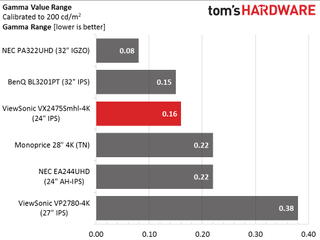
Gamma tracking is nice and flat even with the dips at 10 and 90 percent brightness. Luminance is off by no more than three cd/m2 throughout the entire signal range -- that's well below the threshold of visibility.
We calculate gamma deviation by simply expressing the difference from 2.2 as a percentage.
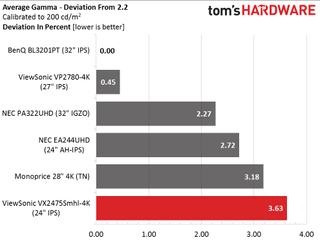
The VX2475Smhl-4K's last-place finish is due to its average gamma value of 2.12, which is a tad lighter than the 2.2 standard. Again, this is not a big deal. We're being picky because, well, that's what you expect of us.
Current page: Grayscale Tracking And Gamma Response
Prev Page Brightness And Contrast Next Page Color Gamut And PerformanceStay on the Cutting Edge
Join the experts who read Tom's Hardware for the inside track on enthusiast PC tech news — and have for over 25 years. We'll send breaking news and in-depth reviews of CPUs, GPUs, AI, maker hardware and more straight to your inbox.

Christian Eberle is a Contributing Editor for Tom's Hardware US. He's a veteran reviewer of A/V equipment, specializing in monitors. Christian began his obsession with tech when he built his first PC in 1991, a 286 running DOS 3.0 at a blazing 12MHz. In 2006, he undertook training from the Imaging Science Foundation in video calibration and testing and thus started a passion for precise imaging that persists to this day. He is also a professional musician with a degree from the New England Conservatory as a classical bassoonist which he used to good effect as a performer with the West Point Army Band from 1987 to 2013. He enjoys watching movies and listening to high-end audio in his custom-built home theater and can be seen riding trails near his home on a race-ready ICE VTX recumbent trike. Christian enjoys the endless summer in Florida where he lives with his wife and Chihuahua and plays with orchestras around the state.
-
JeanLuc The pixel density of a 4K screen is about the same as a high end 1080p smart phone, the picture quality of this must be stunning.Reply -
xenol ReplyThe pixel density of a 4K screen is about the same as a high end 1080p smart phone, the picture quality of this must be stunning.
The monitor is half that, compared against a 6" phone. But at the viewing distances of a monitor, it may as well be effectively greater. -
DisplayJunkie "nicely styled with a gloss-black bezel"Reply
Are you kidding me? Nicely styled? NO. Glossy black plastics are COMPLETE CRAP. They REFLECT the damn displayed image! This is ESPECIALLY horrible when it's used on bezels, it is EXTREMELY annoying.
And glossy black plastics look terribly cheap.
Not to mention black bezels reduces the perceived contrast ratio. Matte grays are the correct choice.
Why do monitor manufacturers keep doing this?
"Just" because of that, this monitor is immediately disqualified from my consideration.
-
xenol Reply24" UHD monitor for gaming? Nope. Just nope. It's too small for me, I'm getting old.
You can think of it this way: you no longer have to deal with anti-aliasing of any kind!
But then again 4K with no AA may as well be the same as 1080p with 4xMSAA (only not since MSAA is much cheaper than 4K still) -
nitrium I often wonder what the scalers are like in these things, i.e. if you run a resolution lower than native - something you may potentially be forced to do to get a playable framerate in gaming for example. Does it look absolute rubbish? How does 1080p look on these screens compared to 1080p on a screen with that as native resolution? Does it generally look better, worse or roughly the same? Are all scalers created equal? Would be very interested to read about this in future articles.Reply -
picture_perfect Here we go again.The best graphics card today will average 40 fps at this resolution. Check any current game. That means an awful gaming experience with judder, blur and lag. Scaling resolution down degrades picture / adds lag. So for gaming I will say NO.Reply
